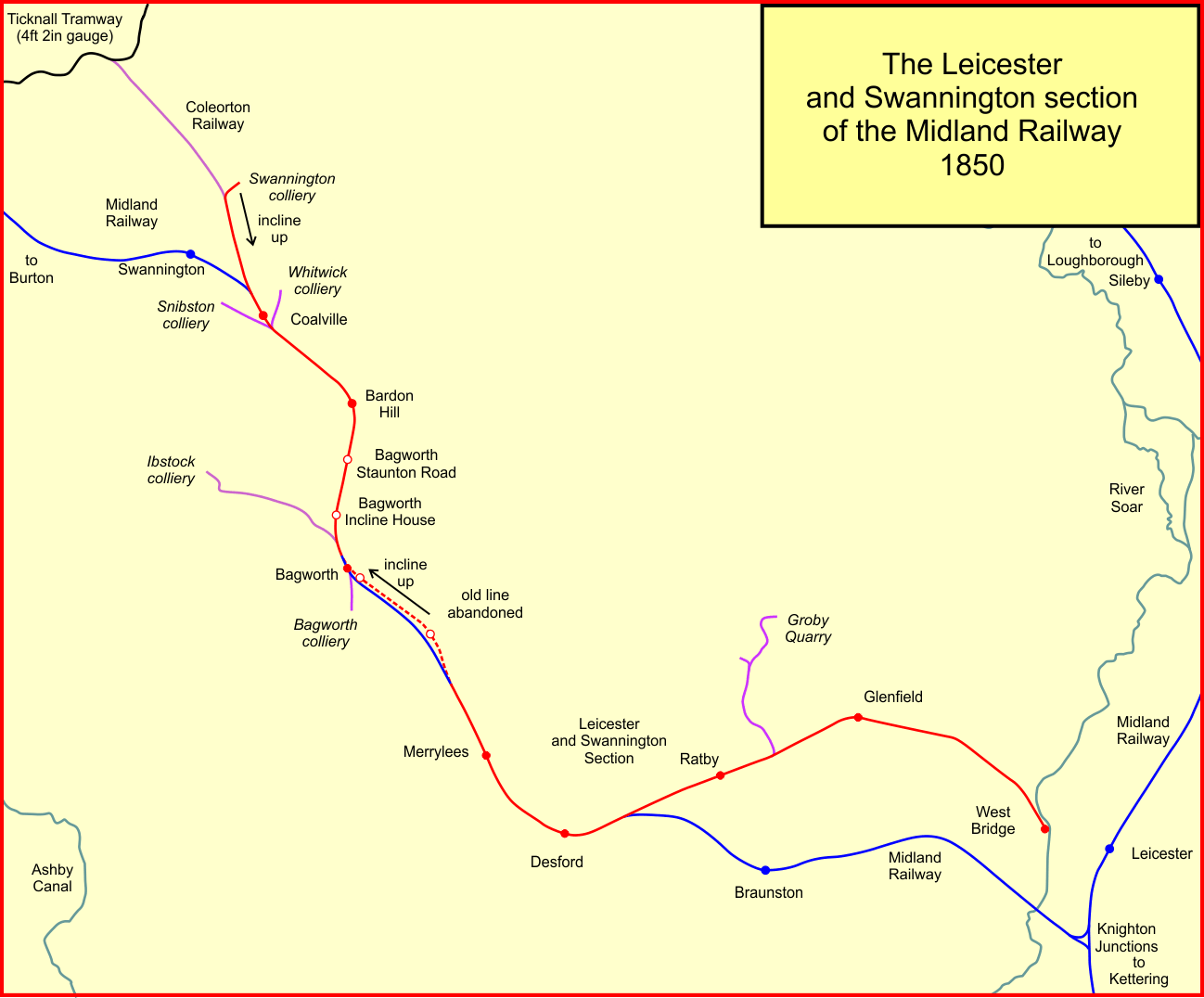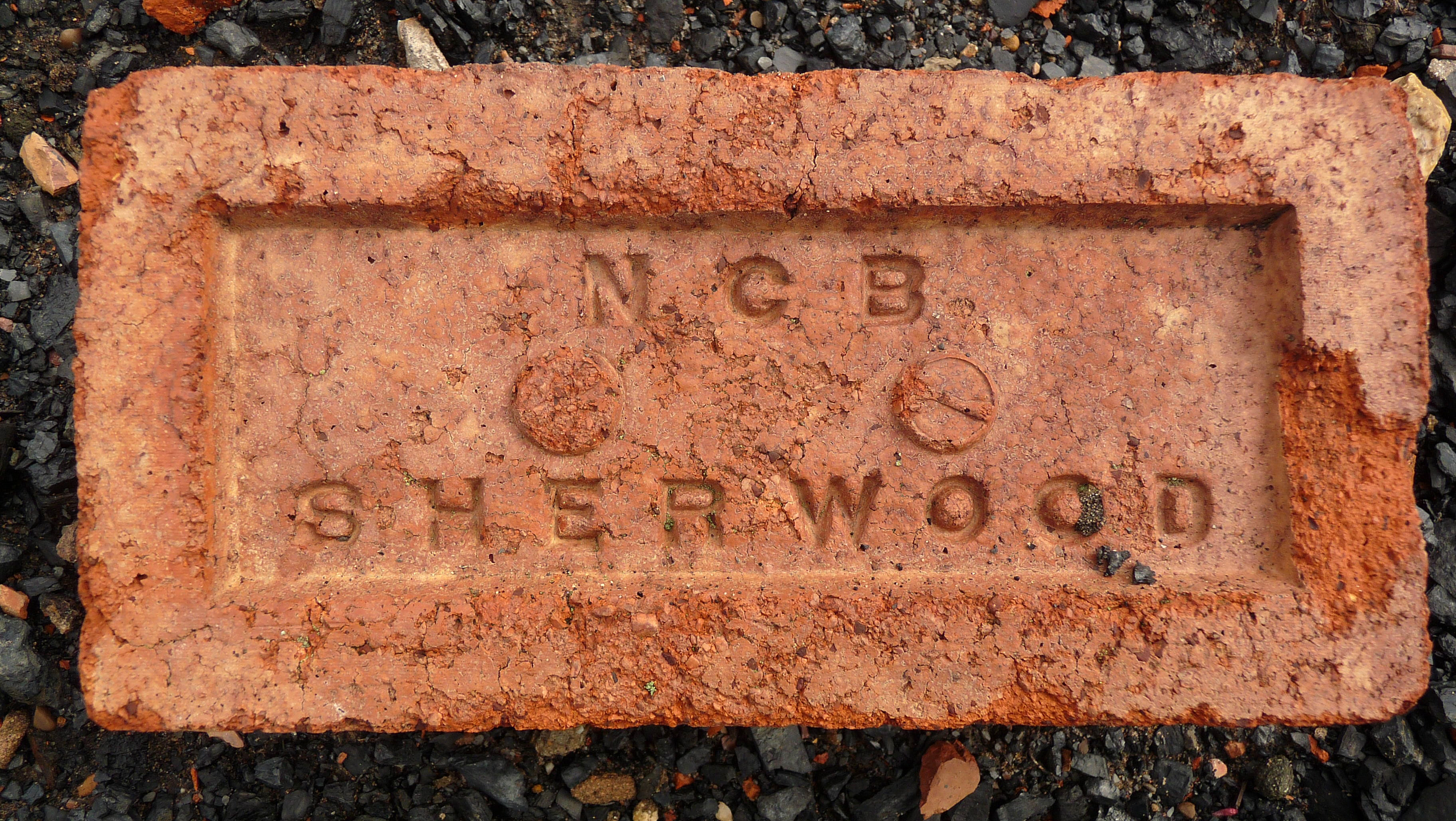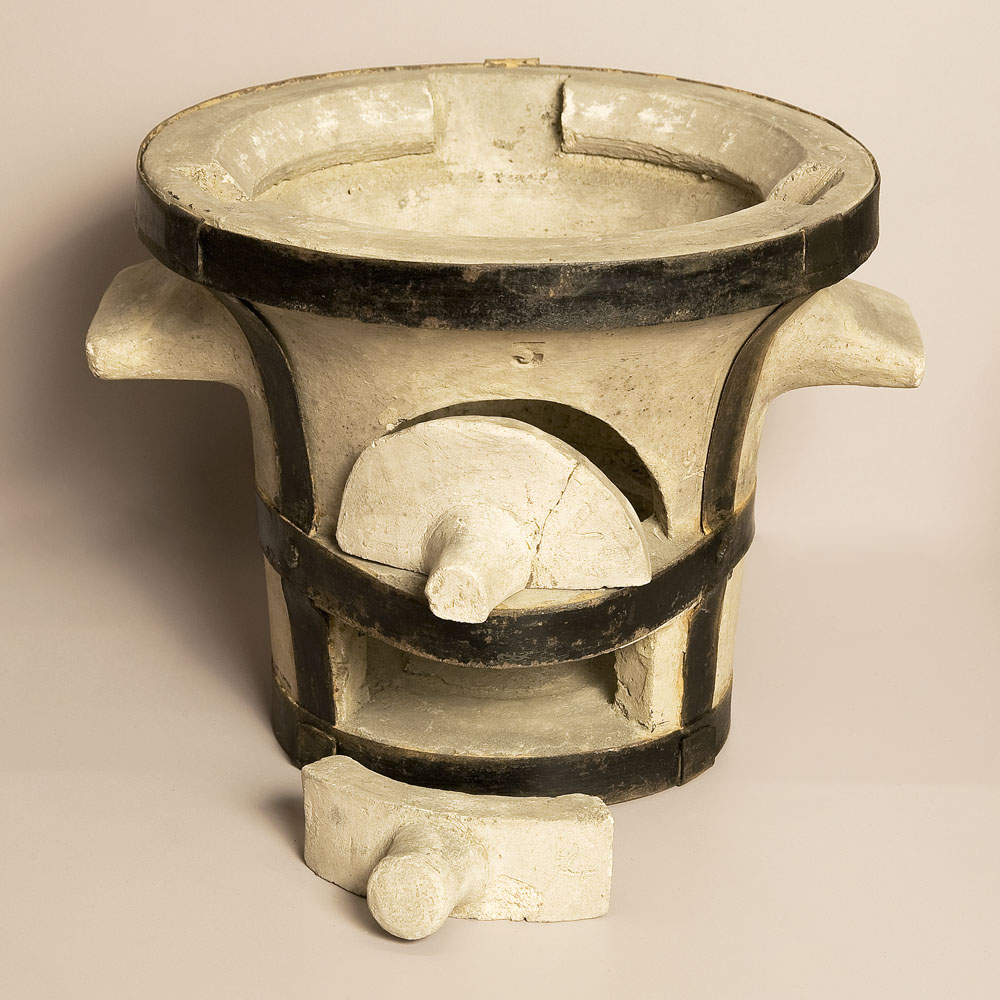|
Leicester–Burton Upon Trent Line
The Leicester–Burton upon Trent line is a freight-only railway line in England linking the Midland Main Line near Leicester to the Derby to Birmingham line at Burton upon Trent. The line was built by the Midland Railway, which had acquired the Leicester and Swannington Railway in 1847, improving it and extending it. It opened throughout in 1849. The line connected an exceptional number of collieries and industrial premises, and several industrial branch lines were built radiating from it. Swadlincote was already an established community engaged in industry and there was a complex of branch lines there. The passenger service on the line was discontinued in 1964, and much of the mining-based industry has closed down; quarrying is the dominant residual originating traffic. There are proposals to reopen the passenger service, and these are under review at present (2022). History Leicester and Swannington Railway In the late eighteenth century and the early nineteenth century, Le ... [...More Info...] [...Related Items...] OR: [Wikipedia] [Google] [Baidu] |
National Rail
National Rail (NR) is the trading name licensed for use by the Rail Delivery Group, a group representing passenger train operating companies (TOCs) of England, Scotland, and Wales. The TOCs run the passenger services previously provided by the British Railways Board, from 1965 using the brand name British Rail. Northern Ireland, which is bordered by the Republic of Ireland, has a different system. National Rail services share a ticketing structure and inter-availability that generally do not extend to services which were not part of British Rail. The brand has a dedicated website (see below) referred to as nationalrail.co.uk. Its brand name used to be 'National Rail Enquiries' denoted by the nomenclature 'NRE'. While today it is more commonly referred to as 'National Rail' by news and media, it is still known by the initials 'NRE'. National Rail and Network Rail ''National'' Rail should not be confused with ''Network'' Rail. National Rail is a brand used to promote pa ... [...More Info...] [...Related Items...] OR: [Wikipedia] [Google] [Baidu] |
George Hudson
George Hudson (probably 10 March 1800 – 14 December 1871) was an English railway financier and politician who, because he controlled a significant part of the Railway Mania, railway network in the 1840s, became known as "The Railway King"—a title conferred on him by Sydney Smith in 1844. Hudson played a significant role in linking London to Edinburgh by rail, carrying out the first major merging of railway companies (the Midland Railway) and developing his home city of York into a major railway junction. He also represented Sunderland (UK Parliament constituency), Sunderland in the House of Commons of the United Kingdom, House of Commons. Hudson's success was built on dubious financial practices and he frequently paid shareholders out of capital rather than money the company had earned. Eventually in 1849, a series of enquiries, launched by the railways he was chairman of, exposed his methods, although many leading the enquiries had benefited from and approved of Hudson's m ... [...More Info...] [...Related Items...] OR: [Wikipedia] [Google] [Baidu] |
London And North Western Railway
The London and North Western Railway (LNWR, L&NWR) was a British railway company between 1846 and 1922. In the late 19th century, the LNWR was the largest joint stock company in the world. Dubbed the "Premier Line", the LNWR's main line connected four of the largest cities in England; London, Birmingham, Manchester and Liverpool, and, through cooperation with their Scottish partners, the Caledonian Railway also connected Scotland's largest cities of Glasgow and Edinburgh. Today this route is known as the West Coast Main Line. The LNWR's network also extended into Wales and Yorkshire. In 1923, it became a constituent of the London, Midland and Scottish (LMS) railway, and, in 1948, the London Midland Region of British Railways. History The company was formed on 16 July 1846 by the ( 9 & 10 Vict. c. cciv), which authorised the amalgamation of the Grand Junction Railway, London and Birmingham Railway and the Manchester and Birmingham Railway. This move was prompted, in ... [...More Info...] [...Related Items...] OR: [Wikipedia] [Google] [Baidu] |
The Old Station, Ashby-de-la-Zouch - Geograph
''The'' is a grammatical article in English, denoting nouns that are already or about to be mentioned, under discussion, implied or otherwise presumed familiar to listeners, readers, or speakers. It is the definite article in English. ''The'' is the most frequently used word in the English language; studies and analyses of texts have found it to account for seven percent of all printed English-language words. It is derived from gendered articles in Old English which combined in Middle English and now has a single form used with nouns of any gender. The word can be used with both singular and plural nouns, and with a noun that starts with any letter. This is different from many other languages, which have different forms of the definite article for different genders or numbers. Pronunciation In most dialects, "the" is pronounced as (with the voiced dental fricative followed by a schwa) when followed by a consonant sound, and as (homophone of the archaic pronoun ''thee'') ... [...More Info...] [...Related Items...] OR: [Wikipedia] [Google] [Baidu] |
Bretby Hall
Bretby Hall is a country house at Bretby, Derbyshire, England, north of Swadlincote and east of Burton upon Trent on the border with Staffordshire. It is a Grade II listed building. The name ''Bretby'' means "dwelling place of Britons". History The first Bretby Hall was built in 1630 after Thomas Stanhope bought the manor of Bretby from the family of Stephen de Segrave, to whom it had been granted by Ranulph de Blondeville, 4th Earl of Chester. In 1628, his grandson Philip was made Earl of Chesterfield by King Charles I of England. From then on, Bretby Hall was the ancestral home of the Earls of Chesterfield. The second Earl was responsible for a complete restyling of the gardens so that some compared them favourably with the gardens at Versailles. The fifth Earl demolished the mansion and built the present Hall (c.1812) to a design by Sir Jeffry Wyatville. The sixth Earl, known as the "racing Earl", loved cricket and shooting, so he built a cricket pitch and raised game b ... [...More Info...] [...Related Items...] OR: [Wikipedia] [Google] [Baidu] |
Henry Herbert, 4th Earl Of Carnarvon
Henry Howard Molyneux Herbert, 4th Earl of Carnarvon, (24 June 1831 – 29 June 1890), known as Lord Porchester from 1833 to 1849, was a British politician and a leading member of the Conservative Party. He was twice Secretary of State for the Colonies and also served as Lord Lieutenant of Ireland. Origins Born at Grosvenor Square, London, Carnarvon was the eldest son and heir of Henry Herbert, 3rd Earl of Carnarvon (d.1849), by his wife Henrietta Anna Howard, a daughter of Lord Henry Howard-Molyneux-Howard, younger brother of Bernard Howard, 12th Duke of Norfolk. The Hon. Auberon Herbert was his younger brother. Youth He was educated at Eton College. In 1849, aged 18, he succeeded his father in the earldom. He attended Christ Church, Oxford, where his nickname was " Twitters", apparently on account of his nervous tics and twitchy behaviour, and where in 1852 he obtained a first in '' literae humaniores''. Early political career, 1854–66 Carnavon made his maiden speec ... [...More Info...] [...Related Items...] OR: [Wikipedia] [Google] [Baidu] |
Bretby
Bretby is a village and civil parish in the south of Derbyshire, England, north of Swadlincote and east of Burton upon Trent, on the border between Derbyshire and Staffordshire. The population of the civil parish as of the 2011 census was 893. The name means "dwelling place of Britons". On the A511 road (formerly A50), there is a secondary settlement, Stanhope Bretby, which was the site of Bretby Colliery. History This manor (''Bretebi'') was in the Domesday Book in 1086. Under the title of "The land of the King (in Derbyshire" it said: In Newton Solney and Bretby Ælfgar had seven carucates of land to the geld. There is land for six ploughs. There the king has one plough and nineteen villans and one bordar with five ploughs. There are of meadow, woodland pasture two leagues long and three furlongs broad. TRETRE in Latin is ''Tempore Regis Edwardi''. This means in the time of King Edward before the Battle of Hastings. as now worth one hundred shillings.''Domesday Book: A C ... [...More Info...] [...Related Items...] OR: [Wikipedia] [Google] [Baidu] |
National Coal Board
The National Coal Board (NCB) was the statutory corporation created to run the nationalised coal mining industry in the United Kingdom. Set up under the Coal Industry Nationalisation Act 1946, it took over the United Kingdom's collieries on "vesting day", 1 January 1947. In 1987, the NCB was renamed the British Coal Corporation, and its assets were subsequently privatised. Background Collieries were taken under government control during the World War I, First and World War II, Second World Wars. The Sankey Commission in 1919 gave R. H. Tawney, Sidney Webb and Sir Leo Chiozza Money the opportunity to advocate nationalisation, but it was rejected. Coal reserves were nationalised during the war in 1942 and placed under the control of the Coal Commission (United Kingdom), Coal Commission, but the mining industry remained in private hands. At the time, many coal companies were small, although some consolidation had taken place in the years before the war. Formation and organisat ... [...More Info...] [...Related Items...] OR: [Wikipedia] [Google] [Baidu] |
Woodville, Derbyshire
Woodville is a large suburban village and civil parish that crosses two districts - South Derbyshire district of Derbyshire and North West Leicestershire district of Leicestershire, England, east of Swadlincote. At the United Kingdom Census 2011, 2011 Census, the parish had a population of 5,161, an increase from 3,420 at the United Kingdom Census 2001, 2001 Census. The centre of the village, known as the Tollgate, is a busy traffic island on the A511 road, A511. Woodville forms part of the border with Leicestershire. History Woodville was formerly known as Wooden Box, named after the wooden toll booth on the toll road between Ashby de la Zouch and Burton-upon-Trent. The area around the roundabout, which is the modern equivalent of the toll booth, is still known as 'Tollgate'. The name Woodville first appeared in a leaflet issued when the foundation stone of the Church of England parish church of St Stephen's Church, Woodville, St Stephen was laid on 7 November 1845. St Step ... [...More Info...] [...Related Items...] OR: [Wikipedia] [Google] [Baidu] |
Fireclay
Fire clay is a range of refractory clays used in the manufacture of ceramics, especially fire brick. The United States Environmental Protection Agency defines fire clay very generally as a "mineral aggregate composed of hydrous silicates of aluminium (Al2O3·2SiO2·2H2O) with or without free silica." Properties High-grade fire clays can withstand temperatures of 1,775 °C (3,227 °F), but to be referred to as a "fire clay" the material must withstand a minimum temperature of .Minerals Zone, World Mineral Exchange. Retrieved 2011-6-23. Fire clays range from '' flint clays'' to ''plastic fire clays'', but there are ''semi-flint'' and ''semi-plastic'' fire clays as well. Fire clays consist of natural [...More Info...] [...Related Items...] OR: [Wikipedia] [Google] [Baidu] |
Leics - Burt 1900
Leicestershire ( ) is a ceremonial county in the East Midlands of England. It is bordered by Derbyshire, Nottinghamshire and Lincolnshire to the north, Rutland to the east, Northamptonshire to the south-east, Warwickshire to the south-west, and Staffordshire to the west. The city of Leicester is the largest settlement and the county town. The county has an area of and a population of one million according to 2022 estimates. Leicester is in the centre of the county and is by far the largest settlement, with a built-up area population of approximately half a million. The remainder of the county is largely rural, and the next-largest settlements are Loughborough in the north, Hinckley in the south-west, and Wigston south-east of Leicester. For local government purposes Leicestershire comprises a non-metropolitan county, with seven districts, and the unitary authority area of Leicester. Leicestershire is generally a lowland county, characterised by small, rolling hills. It is bisec ... [...More Info...] [...Related Items...] OR: [Wikipedia] [Google] [Baidu] |





